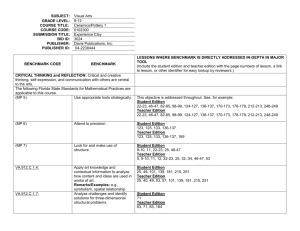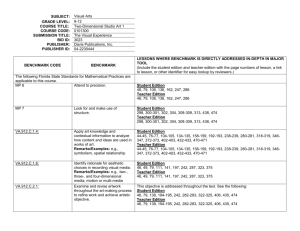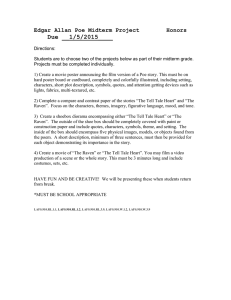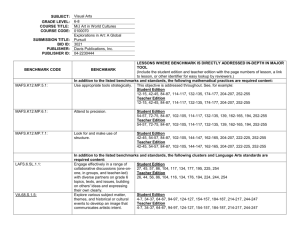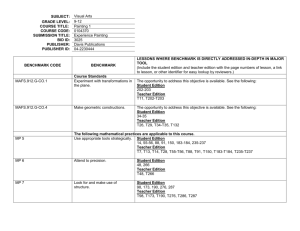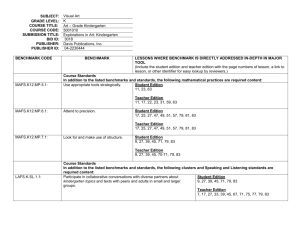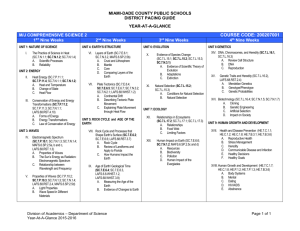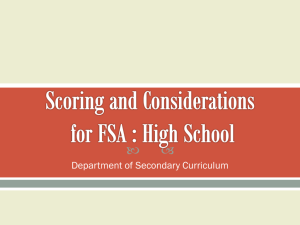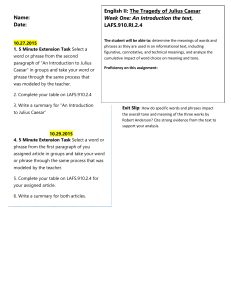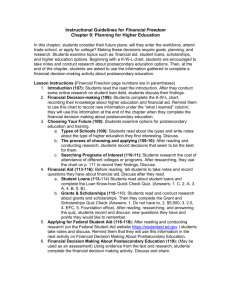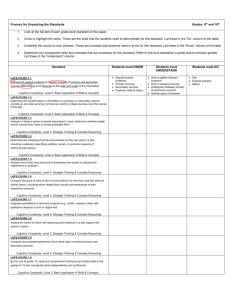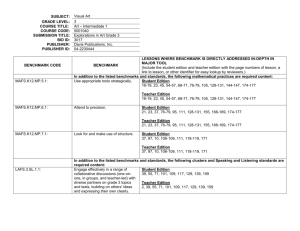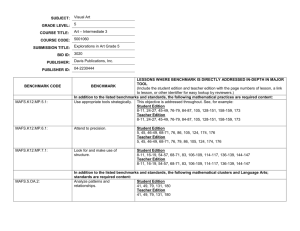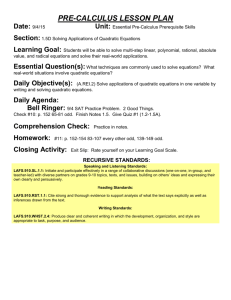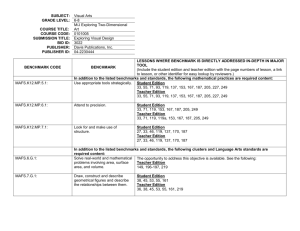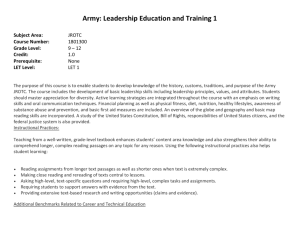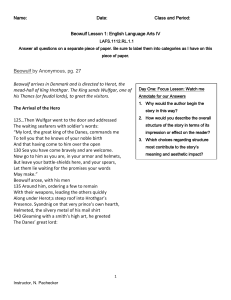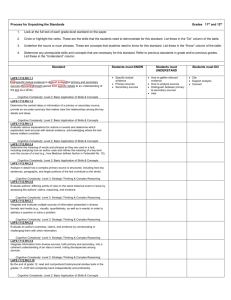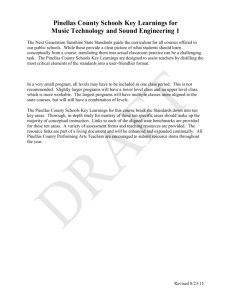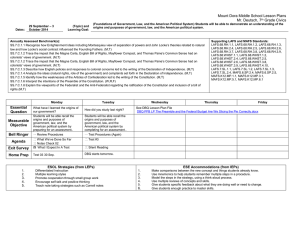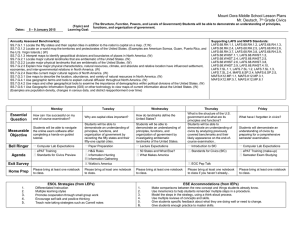Communicating through Graphic Design
advertisement
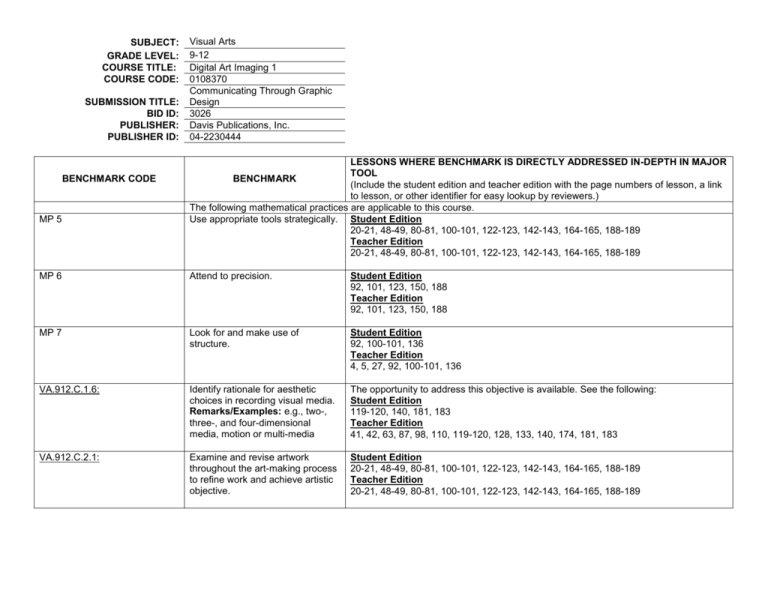
SUBJECT: GRADE LEVEL: COURSE TITLE: COURSE CODE: SUBMISSION TITLE: BID ID: PUBLISHER: PUBLISHER ID: BENCHMARK CODE MP 5 Visual Arts 9-12 Digital Art Imaging 1 0108370 Communicating Through Graphic Design 3026 Davis Publications, Inc. 04-2230444 LESSONS WHERE BENCHMARK IS DIRECTLY ADDRESSED IN-DEPTH IN MAJOR TOOL BENCHMARK (Include the student edition and teacher edition with the page numbers of lesson, a link to lesson, or other identifier for easy lookup by reviewers.) The following mathematical practices are applicable to this course. Use appropriate tools strategically. Student Edition 20-21, 48-49, 80-81, 100-101, 122-123, 142-143, 164-165, 188-189 Teacher Edition 20-21, 48-49, 80-81, 100-101, 122-123, 142-143, 164-165, 188-189 MP 6 Attend to precision. Student Edition 92, 101, 123, 150, 188 Teacher Edition 92, 101, 123, 150, 188 MP 7 Look for and make use of structure. Student Edition 92, 100-101, 136 Teacher Edition 4, 5, 27, 92, 100-101, 136 VA.912.C.1.6: Identify rationale for aesthetic choices in recording visual media. Remarks/Examples: e.g., two-, three-, and four-dimensional media, motion or multi-media The opportunity to address this objective is available. See the following: Student Edition 119-120, 140, 181, 183 Teacher Edition 41, 42, 63, 87, 98, 110, 119-120, 128, 133, 140, 174, 181, 183 VA.912.C.2.1: Examine and revise artwork throughout the art-making process to refine work and achieve artistic objective. Student Edition 20-21, 48-49, 80-81, 100-101, 122-123, 142-143, 164-165, 188-189 Teacher Edition 20-21, 48-49, 80-81, 100-101, 122-123, 142-143, 164-165, 188-189 VA.912.C.2.3: Process and apply constructive criticism as formative assessment for continued growth in art-making skills. Student Edition 123, 165, 174 Teacher Edition 18, 28, 30, 36, 42, 88, 123, 165, 174 VA.912.C.3.1: Use descriptive terms and varied approaches in art analysis to explain the meaning or purpose of an artwork. Remarks/Examples: e.g., four-step method of art criticism, visual-thinking skills, aesthetic scanning Demonstrate effective and accurate use of art vocabulary throughout the art-making process. Student Edition 43, 83, 88, 145 Teacher Edition 41, 43, 63, 75, 83, 88, 128, 134, 145, 147 VA.912.S.1.6: Describe processes and techniques used to record visual imagery. Remarks/Examples: e.g., drawing, sculpting, digital multi-media The opportunity to address this objective is available. See the following: Student Edition 21, 49, 83, 101, 143, 189 Teacher Edition 18, 21, 49, 83, 101, 143, 189 VA.912.S.1.8: Use technology to simulate artmaking processes and techniques. Remarks/Examples: e.g., drawing subtleties, watercolor painting techniques The opportunity to address this objective is available. See the following: Student Edition 20-21, 142-143, 164-165, 188-189 Teacher Edition 20-21, 119, 142-143, 164-165, 188-189 VA.912.S.2.1: Demonstrate organizational skills to influence the sequential process when creating artwork. Student Edition 20-21, 48-49, 80-81, 100-101, 122-123, 142-143, 164-165, 188-189 Teacher Edition 20-21, 48-49, 80-81, 100-101, 122-123, 142-143, 164-165, 188-189 VA.912.S.2.2: Focus on visual information and processes to complete the artistic concept. Student Edition 20-21, 48-49, 80-81, 100-101, 122-123, 142-143, 164-165, 188-189 Teacher Edition 20-21, 48-49, 80-81, 100-101, 112, 122-123, 131, 142-143, 164-165, 182, 188-189 VA.912.S.3.1: Manipulate materials, techniques, and processes through practice and perseverance to create a desired result in two- and/or threedimensional artworks. Student Edition 20-21, 40, 48-49, 80-81, 88, 92, 100-101, 122-123, 142-143, 164-165, 181, 188-189 Teacher Edition 20-21, 40, 48-49, 80-81, 88, 92, 100-101, 122-123, 142-143, 164-165, 181, 188-189 VA.912.S.1.4: Student Edition 20-21, 48-49, 80-81, 100-101, 122-123, 142-143, 164-165, 188-189 Teacher Edition 20-21, 48-49, 80-81, 100-101, 122-123, 142-143, 164-165, 188-189 VA.912.S.3.11: Store and maintain equipment, materials, and artworks properly in the art studio to prevent damage and/or cross-contamination. The opportunity to address this objective is available. See the following: Student Edition 20-21, 48-49, 80-81, 100-101, 122-123, 142-143, 164-165, 188-189 Teacher Edition 20-21, 48-49, 80-81, 100-101, 122-123, 142-143, 164-165, 188-189 VA.912.S.3.12: Develop competence and dexterity, through practice, in the use of processes, tools, and techniques for various media. Remarks/Examples: e.g., printmaking: relief print; ceramics: wheel-throwing; drawing: charcoal; painting: watercolor; technology: layering images Review, discuss, and demonstrate the proper applications and safety procedures for hazardous chemicals and equipment during the art-making process. Remarks/Examples: e.g., electric drill, carving and cutting tools, paper cutter, kiln, Material Safety Data Sheets (MSDS) labels: glazes, chemicals, etching solutions Demonstrate personal responsibility, ethics, and integrity, including respect for intellectual property, when accessing information and creating works of art. Remarks/Examples: e.g., plagiarism, appropriation from the Internet and other sources Follow precisely a complex multistep procedure when carrying out experiments, taking measurements, or performing technical tasks, attending to special cases or exceptions defined in the text. Student Edition 20-21, 48-49, 80-81, 100-101, 122-123, 142-143, 164-165, 188-189 Teacher Edition 20-21, 37, 48-49, 56, 80-81, 89, 100-101, 122-123, 142-143, 158, 164-165, 188-189 VA.912.S.3.3: VA.912.S.3.4: LAFS.910.RST.1.3: The opportunity to address this objective is available. See the following: Teacher Edition T14 Student Edition 57, 76-77 Teacher Edition 57, 76-77, 89 Student Edition 18, 43, 80-81, 83, 88, 117, 122-123 Teacher Edition 18, 43, 80-81, 83, 88, 89, 117, 122-123 LAFS.910.RST.2.4: Determine the meaning of symbols, key terms, and other domain-specific words and phrases as they are used in a specific scientific or technical context relevant to grades 9–10 texts and topics. Compare and analyze traditional and digital media to learn how technology has altered opportunities for innovative responses and results. Solve aesthetic problems, through convergent and divergent thinking, to gain new perspectives. The opportunity to address this objective is available. See the following: Student Edition 135 Teacher Edition 96, 108, 135, 156 VA.912.O.3.1: Create works of art that include symbolism, personal experiences, or philosophical view to communicate with an audience. Student Edition 20-21, 48-49, 88, 97, 100-101, 154 Teacher Edition 20-21, 48-49, 88, 97, 100-101, 154 LAFS.910.WHST.2.4: Produce clear and coherent writing in which the development, organization, and style are appropriate to task, purpose, and audience. Investigate the use of technology and media design to reflect creative trends in visual culture. Student Edition 23, 51, 83, 103, 125, 145, 167, 191 Teacher Edition 23, 34, 51, 72, 83, 86, 88, 103, 125, 145, 167, 181, 191 Gather relevant information from multiple authoritative print and digital sources, using advanced searches effectively; assess the usefulness of each source in answering the research question; integrate information into the text selectively to maintain the flow of ideas, avoiding plagiarism and following a standard format for citation. The opportunity to address this objective is available. See the following: Teacher Edition T11, 34, 72, 86, 135, 151 VA.912.O.1.4: VA.912.O.2.2: VA.912.H.1.5: LAFS.910.WHST.3.8: Teacher Edition 11 The opportunity to address this objective is available. See the following: Student Edition 15, 90 Teacher Edition 15, 90 The opportunity to address this objective is available. See the following: Student Edition 11-13, 14, 118, 119, 129 Teacher Edition 11-13, 14, 118, 119, 129, 170 LAFS.910.WHST.3.9: Draw evidence from informational texts to support analysis, reflection, and research. The opportunity to address this objective is available. See the following: Student Edition 100-101, 142-143 Teacher Edition 63, 72, 86, 96, 100-101, 107, 114, 131, 136, 139, 142-143, 152, 170 VA.912.H.2.1: Identify transitions in art media, technique, and focus to explain how technology has changed art throughout history. The opportunity to address this objective is available. See the following: Student Edition 9-10, 11, 14, 129 Teacher Edition 9-10, 11, 14, 129 LAFS.910.SL.1.1: LAFS.910.SL.1.2: Initiate and participate effectively in a range of collaborative discussions (one-on-one, in groups, and teacher-led) with diverse partners on grades 9–10 topics, texts, and issues, building on others’ ideas and expressing their own clearly and persuasively. a. Come to discussions prepared, having read and researched material under study; explicitly draw on that preparation by referring to evidence from texts and other research on the topic or issue to stimulate a thoughtful, well-reasoned exchange of ideas. b. Work with peers to set rules for collegial discussions and decisionmaking (e.g., informal consensus, taking votes on key issues, presentation of alternate views), clear goals and deadlines, and individual roles as needed. c. Propel conversations by posing and responding to questions that relate the current discussion to broader themes or larger ideas; actively incorporate others into the discussion; and clarify, verify, or challenge ideas and conclusions. d. Respond thoughtfully to diverse perspectives, summarize points of agreement and disagreement, and, when warranted, qualify or justify their own views and understanding and make new connections in light of the evidence and reasoning presented. Integrate multiple sources of information presented in diverse media or formats (e.g., visually, quantitatively, orally) evaluating the credibility and accuracy of each source. The opportunity to address this objective is available. See the following: Student Edition 81, 123, 138, 170 Teacher Edition 5, 16, 28, 36, 81, 88, 98, 108, 114, 123, 138, 154, 170, 172 The opportunity to address this objective is available. See the following: Teacher Edition 34, 72, 86, 151 LAFS.910.SL.1.3: Evaluate a speaker’s point of view, reasoning, and use of evidence and rhetoric, identifying any fallacious reasoning or exaggerated or distorted evidence. The opportunity to address this objective is available. See the following: Student Edition 123, 143, 165, 189 Teacher Edition 123, 143, 165, 172, 189 LAFS.910.SL.2.4: Present information, findings, and supporting evidence clearly, concisely, and logically such that listeners can follow the line of reasoning and the organization, development, substance, and style are appropriate to purpose, audience, and task. Use materials, ideas, and/or equipment related to other content areas to generate ideas and processes for the creation of works of art. Remarks/Examples: e.g., microscope, skeleton, Fibonacci sequence, Golden Mean, measurement: pica, inches, points Use technological tools to create art with varying effects and outcomes. Student Edition 189 Teacher Edition 17, 18, 70, 169, 189, 191 Create a digital or time-based presentation to analyze and compare artists, artworks, and concepts in historical context. Examine career opportunities in the visual arts to determine requisite skills, qualifications, supply-and-demand, market location, and potential earnings. Use digital equipment and peripheral devices to record, create, present, and/or share accurate visual images with others. The opportunity to address this objective is available. See the following: Teacher Edition 107, 139, 181 VA.912.H.3.3: VA.912.F.1.4: VA.912.F.1.5: VA.912.F.2.1: VA.912.F.3.12: Teacher Edition 27, 41, 96, 112, 139, 151, 158 Student Edition 20-21, 80-81, 100-101, 122-123, 142-143, 164-165, 188-189 Teacher Edition 20-21, 80-81, 100-101, 122-123, 142-143, 164-165, 182, 188-189 Student Edition 22-23, 50-51, 82-83, 102-103, 124-125, 144-145, 166-167, 190-191 Teacher Edition T10, 22-23, 50-51, 82-83, 102-103, 124-125, 144-145, 166-167, 190-191 Student Edition 122-123, 142-143, 164-165, 176-177, 181, 188-189 Teacher Edition 122-123, 142-143, 164-165, 176-177, 181, 182, 188-189 VA.912.F.3.4: VA.912.F.3.6: Follow directions and use effective time-management skills to complete the art-making process and show development of 21stcentury skills. Remarks/Examples: e.g., punctuality, reliability, diligence, positive work ethic Identify ethical ways to use appropriation in personal works of art. Student Edition 20-21, 48-49, 80-81, 100-101, 122-123, 142-143, 164-165, 188-189 Teacher Edition 20-21, 48-49, 80-81, 100-101, 122-123, 142-143, 164-165, 188-189 The opportunity to address this objective is available. See the following: Teacher Edition 57, 77
